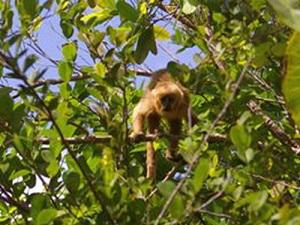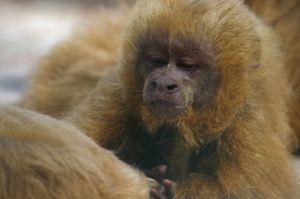Bruna Martins Bezerra
Other projects
12 Jul 2007
Social Ecology of Wild Golden Backed-Uacari in National Park of Jaú (PNJ), Amazônia, Brazil. A Contribution to the Management Plan of the PNJ
8 Sep 2017
In Situ Conservation of the Blonde Capuchins: Predicting Potential Responses to Future Climate and Anthropogenic Disturbances
3 Mar 2022
Blonde Capuchin Research Conservation Project: Understanding Conservation Needs by Creating an Interface Between Research and Society
The study aims to promote the conservation of a primate currently on the brink of extinction and produce extensive knowledge on its behaviour, acoustics and molecular ecology.

Blond capuchin. Photo by Bruna Bezerra.
We will use an integrated approach to understand the conservation needs of the Critically Endangered blond capuchin. Thought extinct, the species was rediscovered in Brazil in 2006. The estimated population is 180 individuals.

Blond capuchin. Photo by Bruna Bezerra.
We will:
(i) investigate the foraging ecology and behavioural repertoires of wild individuals,
(ii) use maximum entropy models to predict (and then test using playback experiments) where other populations might occur and identify potential reintroduction sites,
(iii) use microsatellites to determine levels of inbreeding, relatedness and to identify genetic signatures of population collapse. The study will involve fieldwork in several fragments of Atlantic Rain Forest in the Northeast of Brazil.
Although the Atlantic rainforest is one of the most species-rich habitats on earth, only 2% of the original forest remains and what remains is highly fragmented (Ribeiro et al., 2009). We will determine patterns of hunting pressure on blond capuchins in different sites and the patterns of habitat loss and degradation. Our results will provide a basis for urgent conservation actions in the Atlantic forest in the Northeast of Brazil such as the designation of potential national parks, reserves and protected forests, and the implementation of a powerful conservation education plan. If we detect reduced genetic diversity or inbreeding in the populations of blond capuchin monkeys, efficient plans for linking forest fragments via ecological corridors will be proposed to the local government and hopefully be implemented. We believe our project will have wide impact, will offer considerable value for conservation, and will be high-profile because of the rarity of the study animal.
Our multidisciplinary approach, non-invasive methods and multi-institutional collaboration will provide a research framework that can later be applied to other endangered primates. Furthermore, by using the blond capuchin as a flagship species, we will be able to help the conservation of several other species living in the Atlantic Rain forest. The study will provide great impetus in providing a last chance to save the blond capuchins. The study will benefit the conservation of a primate on the brink of extinction.
Reference:
Ribeiro MC et al. (2009). The Brazilian Atlantic Forest: how much is left, and how is the remaining forest distributed? Implications for conservation. Biol Conserv 142: 1141-1153.